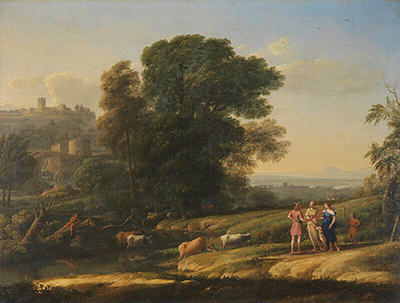Upon viewing this famous Claude Lorrain painting, we are first struck by the beauty of the landscape in front of us. The figures to the right, however, deliver the main content of this piece.
Landscape with Cephalus and Procris Reunited by Diana was constructed in 1645 by Claude for a patron living in Paris. He had managed to acquire a strong list of patrons on an international scale having initially set himself up in the city of Rome. He would also gain commissions from Kings and Popes as his career developed. This particular work was inspired by a story found in Ovid's Metamorphoses (Book VII). The poet has been well received by a large number of artists over the years, and so many are entirely familiar with his most famous poems. The story touched on in this painting regards how Procris was killed by her husband, Cephalus, in an unfortunate hunting accident. Within this artwork we also find goddess Diana who brings Procris back to life and then re-unites the relieved couple. Other artists have taken on this story, but chosen to depict it in many different ways, with this being one of the more relaxed interpretations, with the figures placed within a stunning, sprawling landscape scene.
Ovid’s Metamorphoses made use of a number of characters from Greek mythology and Claude would refer to elements of the poem several times within his work. He also used classical architecture within some of his paintings and so was happy to call upon historical inspiration within his work. The Baroque era did much the same with other's artists across Europe and so this was nothing new, with many patrons requesting such content proactively. Claude always did his best to allow the landscape to be as dominant as possible, because that is where is heart remained, as well as his technical ability. He understood the need to work to the market, and listen to his patrons, but was strong enough to continue to follow a successful formula in which his figures would be relatively small and set within stunning backdrops. It was his use of light and landscape detail which made him so popular and so these mythological topics were merely the extras on top.
Other related works by Claude included Landscape with the Death of Procris, although the artist's studio may have heavily contributed to the work on this piece. Nicolas Poussin’s Cephalus and Aurora (1630) and Peter Paul Rubens' Aurora abducting Cephalus offer examples of how other painters at the time would also take on this theme. The National Gallery owns both of these items as well, offering an interesting study contrast for students. They filled their gallery with Claude paintings when it first opened, before adding other artists over time, with the likes of Rubens and Poussin now also very well represented here. It is today one of the most important art galleries in the world, with a particularly impressive selection for the periods between the Baroque era up to the Romanticists, with plenty else also featured here within its walls.




